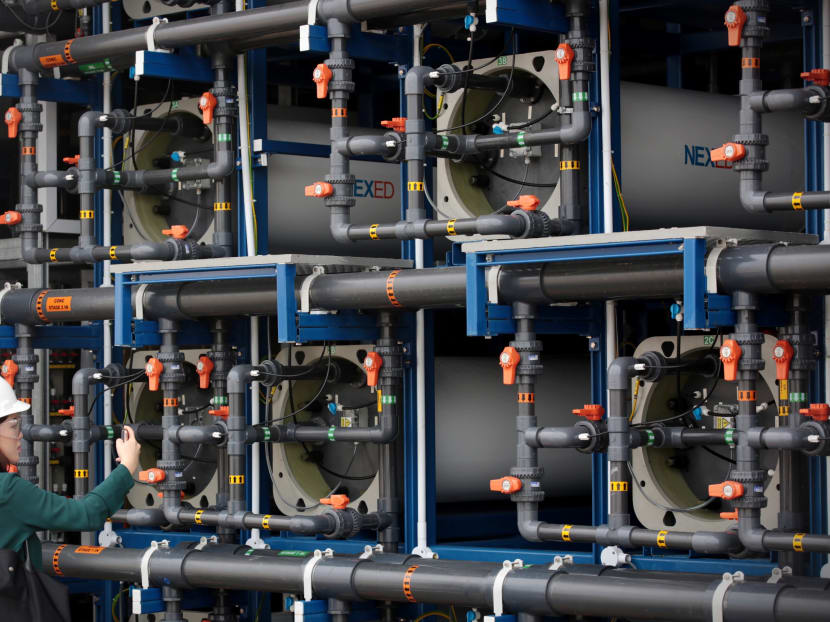PUB aims to double water supply by 2060 without using more energy or producing more waste
SINGAPORE — National water agency PUB has set a target to meet future demand by doubling the amount of clean water it produces today by 2060 without using more energy.

Desalination modules seen at the E-Desalination Demonstration Plant during a site visit on July 4, 2018.
SINGAPORE — National water agency PUB has set a target to meet future demand by doubling the amount of clean water it produces today by 2060 without using more energy.
That is one of several long-term goals that the PUB committed to on Wednesday (July 4), as it soldiers on with research and development (R&D) efforts to increase water resources for the future and improve water treatment efficiency.
Through new technologies, it aims to reduce the energy used in desalination by more than two-thirds, increase the amount of NEWater recovered from used water to 90 per cent at low energy levels, and produce as much energy as it uses in treating used water.
Since 2002 till last year, the agency, its research partners and the National Research Foundation have pumped in S$453 million in 613 water R&D projects, more than three-quarters of which have moved towards full-scale deployment.
The agency is also looking into reducing the amount of waste — produced in the form of sludge — that it has to dispose of. Sludge, a mixture of organic materials, minerals and other waste materials filtered out during water treatment, is costly to incinerate and dispose of in the landfill.
Of Singapore's four national taps, desalinated water and NEWater meet up to 70 per cent of today's water demand. That is projected to go up to 80 per cent in 2030 and 85 per cent in 2060.
Desalinated water, which currently meets up to 30 per cent of water demand and will meet 30 per cent of future demand in 2060, is the most energy-intensive water source. NEWater, on the other hand, currently makes up 40 per cent of water demand, and meet up to 55 per cent of future demand in 2060.
However, both desalinating seawater and getting NEWater from used water require between five and 17 times more energy than the conventional method of treating rainwater.
Mr Harry Seah, PUB's assistant chief executive of future systems and technology, said that if PUB sticks to current technologies, it will have to use four times more energy and produce twice as much sludge as today to meet Singapore's water demand in 2060. This is unsustainable and can only be overcome using innovative technologies.
"The question is affordability. We are expecting the cost of energy to go up," he added. "If we don't do anything today, the cost of producing water is going to go up too."
While Mr Seah stopped short of saying this would lead to higher water prices for consumers, he noted that being efficient with energy usage is key to maintaining water prices.
"There are a lot of other factors besides energy — there's manpower, for example. We do our part through efficiency to drag (having to increase prices) as long as possible," he said.
DIFFERENT METHODS TO REDUCE ENERGY USE
Over the next five to 10 years, the agency plans to reduce its energy consumption for desalination by more than half. In the long term, it plans to whittle this down to more than two-thirds.
One method PUB is testing out at its R&D facility in Tuas is the electro-deionisation technology. This technology uses an electric field to pull dissolved salts from seawater, which requires less energy than the current method of reverse osmosis — pushing seawater through membranes that filter out salts and impurities.
The PUB plans to implement the technology, alongside reverse osmosis, next year at the newly opened Tuas Desalination Plant. It also plans for Singapore's sixth desalination plant, which has not been identified yet, to process seawater using purely electro-deionisation.
Another method being studied at the Tuas R&D facility is the biomimetic membrane. These membranes use natural proteins found in cell membranes that can desalinate seawater more efficiently.
As for NEWater, where the current amount of energy used turns only 75 per cent of the treated used water into NEWater through reverse osmosis, PUB's goal is to up the production to 90 per cent using less than half of the energy used.
Lastly, in the short term, the agency wants to be able to produce as much energy as it uses in water reclamation plants. To do so, it is tapping on sludge, which is usually seen as a waste product.
However, when sludge breaks down, it produces biogas, which can be used as a source of energy. Since at least the 1990s, PUB has been using sludge to produce biogas, which it then uses to power the water reclamation plants.
Currently, this method of using sludge to produce biogas allows PUB's water reclamation plants to produce 25 per cent of the energy it requires. The plan is to move the energy self-sufficiency level to 75 per cent, with the ultimate goal set at 100 per cent.
Through this, PUB can also reduce the amount of sludge it has to dispose of by more than 50 per cent in the long term. The process will double the amount of used water that can be treated at today's sludge footprint too.
The various technologies being tested will be showcased at Singapore International Water Week 2018, to be held from Sunday (July 8) to July 12.
Clarification: An earlier version of this story cited Mr Harry Seah as PUB's assistant head of future systems and technology. PUB has clarified that he is the assistant chief executive of future systems and technology.











